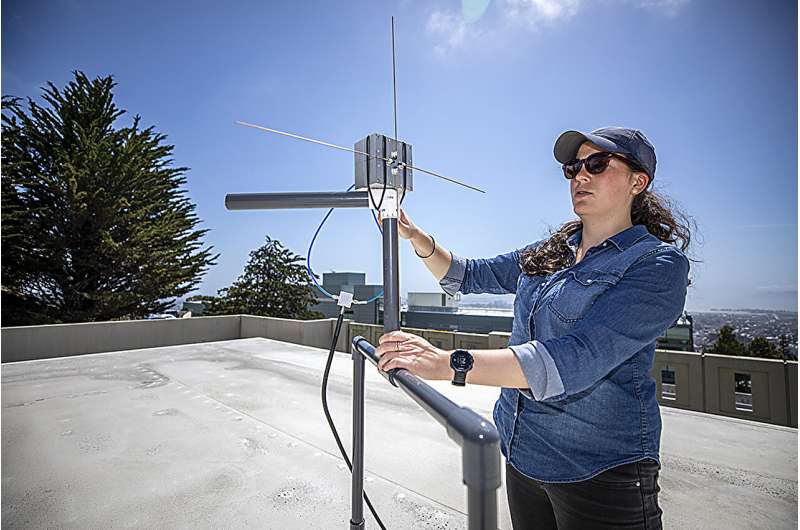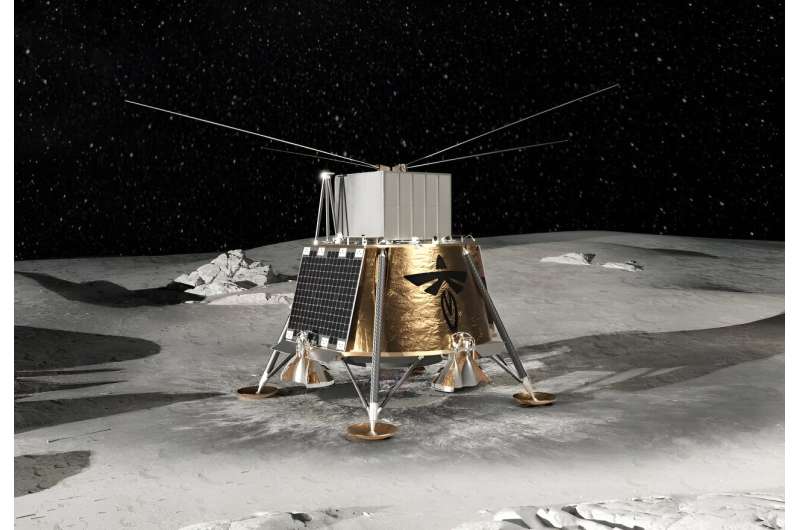The Berkeley Lab team has started building the experiment's antenna that will try to tune in to those ancient radio waves.
"If you're on the far side of the moon, you have a pristine, radio-quiet environment from which you can try to detect this signal from the Dark Ages," said Kaja Rotermund, a postdoctoral researcher at Berkeley Lab who is working on the antenna. "LuSEE-Night is a mission showing whether we can make these kinds of observations from a location that we've never been in, and also for a frequency range that we've never been able to observe."
The Dark Ages signal can't be measured from the Earth because our atmosphere absorbs, refracts, and reflects the radio signal before it ever reaches instruments on the ground. Even if it could, the radio signal would be drowned out by noise from our own electronics and communications.
The moon acts as a shield, blocking out radio waves from Earth. And by gathering data only during the two-week lunar night, the experiment can also block out radio waves from the sun. But this isolated spot also brings challenges. LuSEE-Night must operate in temperatures around -280 degrees Fahrenheit, then weather an extreme swing to 250 degrees Fahrenheit during lunar day, when it will recharge its batteries.
And because the far side of the moon never faces Earth, direct communication with the experiment is impossible. LuSEE-Night will have to send all its data through a relay satellite that passes overhead.
"The engineering to land a scientific instrument on the far side of the moon alone is a huge accomplishment," said Aritoki Suzuki, who leads the antenna project for Berkeley Lab. "If we can demonstrate that this is possible—that we can get there, deploy, and survive the night—that can open up the field for the community and future experiments."
Rocking out to the dark ages
After the big bang, the universe was filled with a hot, opaque plasma of roaming particles. After about 400,000 years, the plasma had cooled enough for protons and electrons to combine into hydrogen, freeing light to travel through the universe. That light, known as the cosmic microwave background or CMB, reached our telescopes and gave us a baby picture of our universe. After that, hydrogen gas dominated for nearly 400 million years during the Dark Ages, until the first stars and galaxies began to form at the cosmic dawn.
"With the CMB, we have this snapshot of the early universe. And we also have images from the more recent universe, once the stars are born," Suzuki said. "We want to study the Dark Ages period because it connects how the early universe evolved into the universe we see today."
Researchers expect that the hydrogen absorbed some of the energy from the CMB at a particular frequency. As the universe expanded, the frequency shifted lower and might now be picked up as radio waves. LuSEE-Night will listen for frequencies between 0.5 and 50 megahertz, though it's likely that future, more sensitive experiments will be needed to find the faint signal.
"We're looking for this very tiny dip that is potentially the Dark Ages signal," Rotermund said. "We can learn a lot about the cosmology that's being governed during this time period in a way that is unaffected by stars and other objects that grow very differently, compared to the universe in general."
From the lab to the moon
To collect radio waves, LuSEE-Night will use two pairs of antennas that are six meters from tip to tip—but the whole experiment must travel to the moon in a cube with one-meter sides. Once LuSEE-Night lands, the spring-loaded "stacer" antennas will uncoil into position.
To make the antenna system for its lunar voyage, Berkeley Lab researchers began with simulations and models and then turned to building and testing.

The team headed to the roof of one of Berkeley Lab's buildings with a scale model of one antenna, reduced from 3 meters to 30 centimeters. They used a transmitter to send signals to the antenna across the wide-open space.
"It's important to characterize our antennas so we're confident in the information that we're getting, and so that we set it up in a way that has the best chance of seeing the Dark Ages signal," Rotermund said. The team has figured out the best design, simulated what the antennas' beam patterns will look like, and calibrated the electronics so they can tell how strong a signal they are receiving.
The Berkeley Lab team is also building a turntable that will periodically rotate the antennas. Because researchers expect the Dark Ages signal to be the same in all directions, any signal that changes after the spin can essentially be filtered from the data. That includes radio noise from other planets or galaxies, or even variations caused by the rocky surface (the "lunar regolith") underneath the experiment.
Following a successful technical review in summer, the team is now working with UC Berkeley's Space Science Laboratory and building the flight model that will head to the moon. They'll deliver the final antenna subsystem by January 2024, where it will be integrated with LuSEE-Night's other components—including the whopping 110-pound (50-kg) battery that sustains it through the night. The experiment will head to the moon on a future Commercial Lunar Payload Services (CLPS) flight operated by Firefly Aerospace and collect data for 18 months.
Provided by Lawrence Berkeley National Laboratory



